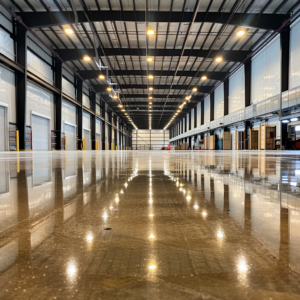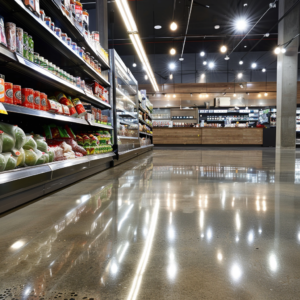When it comes to commercial and industrial flooring, budget considerations play a pivotal role in decision-making processes. Traditional flooring options like carpet, hardwood, and tile have long dominated the market, but a shift is underway. Polished concrete is rapidly emerging as the preferred choice for those seeking a blend of cost-effectiveness, durability, and aesthetic appeal.

Let’s examine the reasons polished concrete is outpacing traditional materials, offering a smarter, more sustainable flooring solution for modern spaces.
Initial Costs and Long-Term Savings
While the upfront cost of polished concrete may be comparable to, or in some cases slightly higher than, traditional flooring materials, it’s the long-term perspective where polished concrete truly shines. Unlike carpet, vinyl, or wood, which require regular replacements every few years, polished concrete boasts a lifespan that can exceed decades. This longevity significantly reduces the need for costly renovations and replacements, leading to substantial savings over time.
Minimal Maintenance Requirements
The cost of maintaining a floor can quickly add up, especially in high-traffic environments. Traditional materials often require specialized cleaning products and equipment, not to mention the periodic need for waxing, sealing, or refinishing. Polished concrete, on the other hand, requires minimal maintenance — regular sweeping and occasional damp mopping with a neutral cleaner are typically all that’s needed to keep the floor looking its best. This low maintenance requirement translates into direct savings on cleaning supplies, equipment, and labor.
Durability and Resilience
Polished concrete’s superior durability stands up to the wear and tear of heavy foot traffic, machinery, and spills far better than traditional materials. This resilience means fewer repairs and less frequent replacements, equating to more savings. The hard surface of polished concrete is resistant to scratches, dents, and stains, making it an ideal choice for commercial and industrial settings where durability is paramount.

Aesthetic and Design Flexibility
One might assume that cost-effective flooring solutions limit design options, but polished concrete breaks the mold. It offers a wide range of finishes, colors, and patterns, thanks to advances in concrete mixing and finishing technologies. This versatility allows businesses to achieve a high-end, customized look without the premium price tag associated with materials like marble or high-grade wood. Additionally, polished concrete can be refreshed and re-polished to update the look without a complete overhaul, further enhancing its cost-effectiveness.
Environmental Sustainability
Sustainability is increasingly important in building design, and polished concrete contributes positively to green building initiatives. It utilizes the existing concrete slab, reducing the need for new materials and the environmental impact associated with their production and transportation. Moreover, polished concrete’s reflective surface can improve indoor lighting efficiency, potentially reducing energy costs associated with artificial lighting.
Flooring Solutions
As businesses strive to balance aesthetics, functionality, and budget, polished concrete emerges as the clear winner over traditional flooring materials. Its cost-effectiveness, combined with durability, minimal maintenance requirements, design flexibility, and environmental benefits, make it an unrivaled choice for modern commercial and industrial spaces. By opting for polished concrete, organizations can achieve a high-quality, sustainable flooring solution that stands the test of time, both in terms of style and substance.



